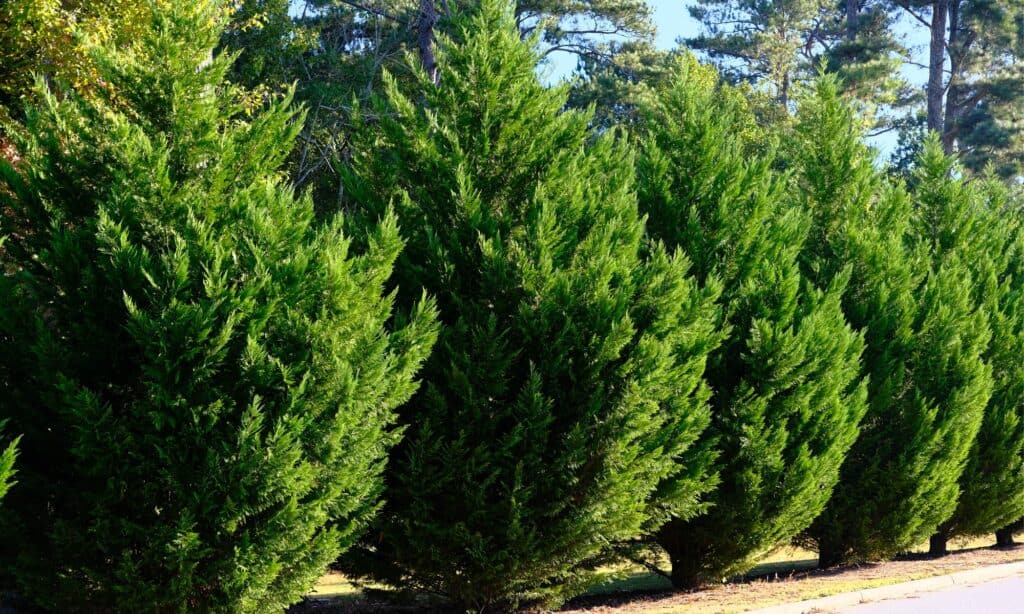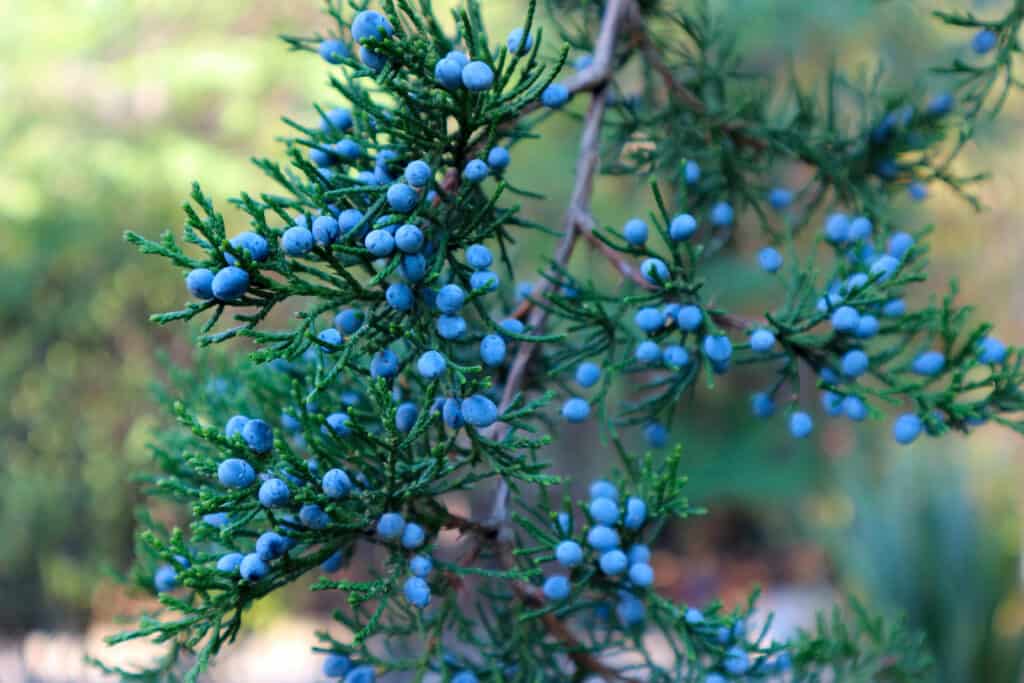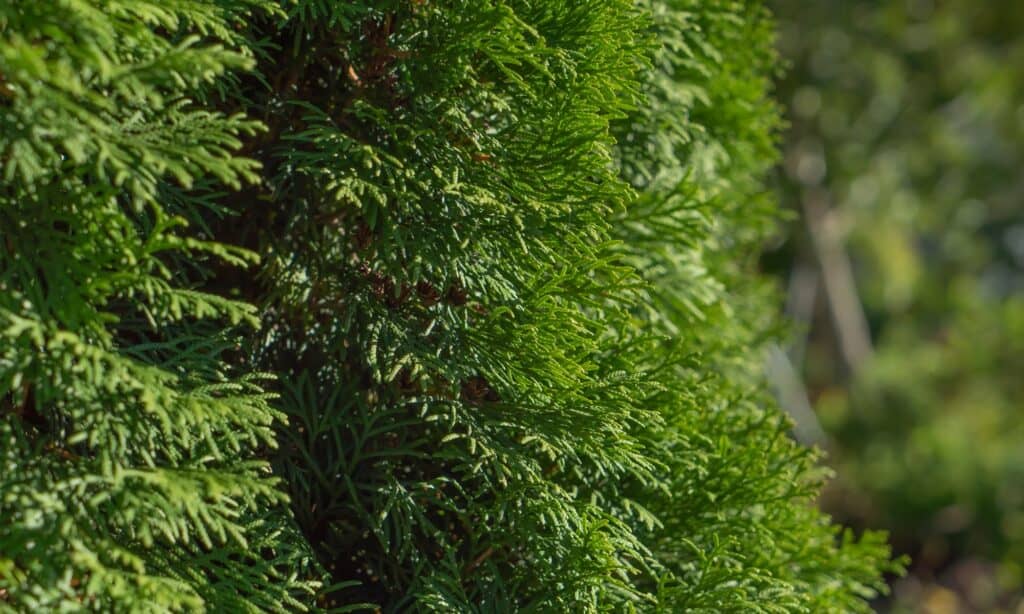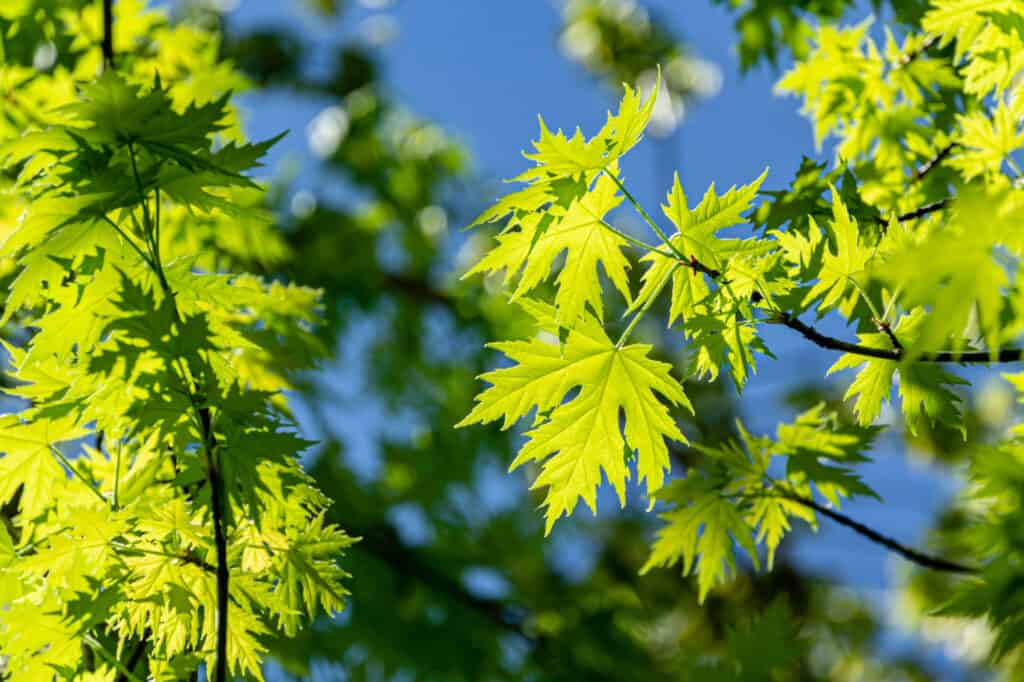Do you plan to hide from inquisitive eyes and seek refuge from the blazing sun somewhere outside your home, in your yard, or on your patio? Then finding out about fast-growing privacy trees would be a great idea so you can plant one or several of them there! Growing the fastest privacy trees will allow you to create a luscious, deep-green natural fence that will give you privacy quickly and for many years. It is also a fantastic way to support the environment! You can use living trees to create a private environment rather than wood from cut ones! Are you curious to know more about growing privacy trees? Read this article to discover the 5 fastest growing privacy trees for your yard!
1. Bald Cypress
Bald cypress trees are frequently planted in the same places as evergreen trees, such as alongside property lines, at property corners, and as focal points in yards. It is native to the Southeast of the United States. They are excellent for giving your yard more screening and privacy. It can increase in height by more than 100 feet and grow up to 2 feet per year! It typically grows to a height of 35 to 120 feet, with a trunk diameter of 3 to 6 feet.
This tree can survive in a range of soil types, including wet, dry, salty, and marshy ones. It is tough and durable. Bald cypress can withstand strong winds, ice, and snow without suffering much, if any, harm. It is noted for the russet-red fall color of its lacy needles. The bald cypress sheds its needles every winter, and they are then restored in the spring. The tree produces cones in April, and the seeds are ready to ripen in October. The cones are commonly eaten by wildlife.
Hardiness Zones:
The hardiness Zones for bald cypress include 4–9, 5–10, and 4–11. There are accounts of bald cypress flourishing in Zones 5 or colder such as in New York and Minnesota. The oldest living bald cypress tree in North America is believed to be at least 2,624 years old and can be located along the Black River in North Carolina!

The bald cypress tree grows up to 2 feet per year producing cones each April with seeds ripening in October.
©iStock.com/corridor91
2. Leyland Cypress
A common evergreen tree used in gardening, the Cupressus leylandii is often known as the Leyland cypress or simply as leylandii. Even in somewhat untamed areas, these coniferous trees have been reported to reach heights of 49 feet in only 16 years with a maximum height of up to 60 feet. Occasionally, because of their rapid development, they are used for providing privacy. The tree is a hybrid of the Monterey cypress and the Nootka cypress. Since it is a hybrid, cuttings are the primary method of propagation, and it is usually sterile. Leyland cypresses grow roughly 3 to 4 feet tall and 2 to 3 feet wide per year, which is a very rapid rate!
Leyland Cypress is a tall tree with a compact and thick appearance. The leaves’ branches are flaky and have a light fragrance. The branches are slightly flattened and covered in many scaly needles. The bark of the tree is deeply incised and either dark reddish or brownish in hue. Cones are created, but they gradually dry out, contract, and turn gray or brown.
Hardiness Zones:
Zones 6 to 10 are predicted to support the Leyland cypress’s growth. It is important to note that they need at least 6 hours per day of direct sunlight.

Leyland cypress trees grow at a rapid rate of roughly 3 to 4 feet in height and 2 to 3 feet in width per year.
©iStock.com/dbvirago
3. Eastern Red Cedar
The eastern red cedar is an evergreen tree that has scale-like leaves, tiny yellow blooms, and cones that resemble blueberries. In North America, this medium-sized coniferous tree is widespread. Easter red cedars are well-known as evergreen hedge plants in addition to being towering specimen trees because of their dense foliage. This coniferous evergreen tree typically grows to a height of 16 to 66 feet, with a trunk diameter of 12 to 39 inches. It expands by around 2 feet annually.
This simple-to-grow evergreen, known as a “pioneer tree,” grows well in various soil types and spreads readily in open spaces. The eastern red cedar serves a variety of purposes in garden landscaping due to its durability. It is a striking specimen tree with a pointed form and columnar growth that resembles an exclamation point. It develops into a structured hedge and is also a well-liked Christmas tree species among evergreens.
Hardiness Zones:
The eastern red cedar’s natural habitat in North America extends from the East Coast to South Dakota in the Midwest. The hardy evergreen conifers also flourish in cold climates, from USDA Zones 2 – 9 in the eastern half of Texas and in Northern Florida.

The eastern red cedar is an evergreen tree that has scale-like leaves, tiny yellow blooms, and cones that resemble blueberries.
©iStock.com/Lyudmila Chetvertnykh
4. Thuja ‘Green Giant’ (Arborvitae)
Thuja is a genus of coniferous trees and shrubs in the Cupressaceae family. The Thuja ‘Green Giant’ is the ideal quickly growing evergreen for a windscreen or privacy hedge. They have bark that is reddish-brown and somewhat stringy. The shoots are flat except for young seedlings, which have tiny needle-like leaves and a scale-like appearance. Thuja trees are evergreen and can grow up to 60 feet tall, adding 3 to 5 feet each year. They can grow up to 20 feet wide.
The Thuja ‘Green Giant’ is a tall, lean shrub that looks grand in practically any environment where it is planted, whether it is in a field of gleaming greenery or a nearby patch of vegetation. This stunning green monster is distinguished by its flattened cascades of leaves that resemble scales. The plant’s bright green leaves darken a little throughout the colder months. Its densely overlapping leaves give the tree a solid appearance. Since the tree can retain its foliage throughout the winter, its dense composition makes it the ideal site for little birds and other creatures to choose as their home. Additionally, the Thuja ‘Green Giant’ produces seeds that the animals eat!
Hardiness Zones:
Zones 5 – 9, primarily in the Southeastern states, are ideal for the Thuja ‘Green Giant’. Hardiness Zones 6 – 8 are where they function best within that region.

The
Thuja‘Green Giant’ is distinguished by its flattened cascades of leaves that resemble scales.
©iStock.com/IgorTsarev
5. Silver Maple
Acer saccharinum sometimes referred to as the silver maple, is one of the most widely distributed trees in the United States. The silver maple is a sizable tree that will offer privacy and shade for your yard. It has five-lobed leaves similar to several other maples, however, it is distinguishable because the underside is silvery. For a deciduous tree, the silver maple grows relatively swiftly, often reaching heights of 49 to 82 feet, and on rare occasions even 115 feet. Usually, it will open up to a width of 36 to 49 feet. It grows at a rate of about two feet or more every year. A 10-year-old sapling will be around 26 feet tall. It is a remarkably adaptable species and is frequently found in wetlands and close to rivers, earning the moniker “water maple.”
Simple, palmately veined leaves with sharp angular notches are present on the silver maple. Even a light breeze can leave a stunning impact by revealing the downy silver undersides of the leaves thanks to their long, slender stems. The fall color is less noticeable than in many maples and normally turns out to be a pale yellow, however certain types can produce more vivid yellow and orange, and red colorations. Compared to other maples, the tree frequently changes color and sheds its leaves a little bit early in the fall.
Hardiness Zones:
The hardiness of maples varies. Zones 4 – 8 are where most are grown. The silver maple does best in climate Zones 3 – 9.

One of the most common trees in the US, silver maples will offer privacy and shade for your yard.
©Marinodenisenko/Shutterstock.com
Up Next
- Discover the 5 Fastest Growing Trees in Florida
- Discover the 5 Fastest Growing Trees in New York
- Discover the 5 Fastest Growing Trees in California
The photo featured at the top of this post is © iStock.com/Ali Çobanoğlu
Sources
- Better Homes & Gardens / Accessed November 12, 2022
- The Yard and Garden / Accessed November 12, 2022
- Tips Bulletin / Accessed November 12, 2022
Thank you for reading! Have some feedback for us? Contact the AZ Animals editorial team.







